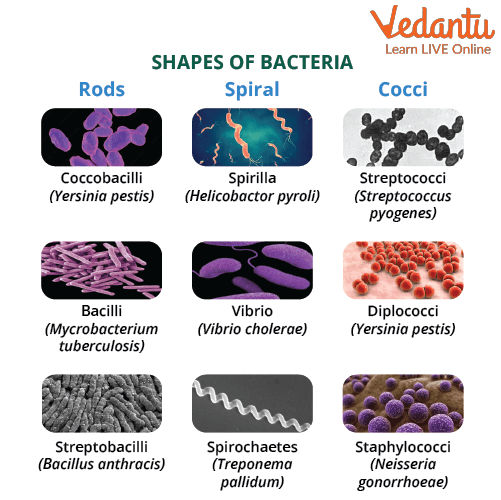Monera
Types of Monera (bacteria)
Spherical (cocci)
Rod (bacillus)
Spiral (spirillum)

Bacteria
Microscopic.
Single-celled.
Have a cell wall (shape & structure).
Have chromosomes containing DNA.
Do not have a nucleus or membrane enclosed organelles..
Sometimes Present:
Have a single loop of DNA (Plasmid). Responsible for bacterial resistance to antibiotics.
Have mesosomes for respiration and cell division.
Flagella for movement.
Capsule for protection (endosphere).

Bacteria Reproduction
Bacteria reproduce asexually - in a method called binary fission - their offspring are genetically identical.
As there is little recombination of genetic material in this method of reproduction one would expect that bacteria would be slow to evolve.
Bacteria has a very short life cycle (some can reproduce every 20 minutes).
New mutations can spread very quickly.
This is how bacteria evolve resistance to new antibiotics.

Endospore Formation
When conditions become unfavourable bacteria can produce a tough wall called an endospore.
Bacterial chromosome replicates as in binary fission.
One of the new strands becomes enclosed in a tough-walled capsule called an endospore.
The parent cell then breaks down and the endospore remains dormant.
When conditions are favourable the spores absorb water, break their walls and reproduce by binary fission.
Biological Weapons
18th September 2001
Several news media offices and two democratic senators received letters with anthrax.
17 people infected - 2 died.
Nutrition
Autotrophic: Photosynthetic & Chemosynthetic
Heterotrophic: Saprophytic & Parasitic
Photosynthetic
Make carbohydrate using light energy from the sun.
e.g. Purple Sulfur Bacteria
Chemosynthetic
Use energy released by a chemical reaction to provide energy for carbohydrate production.
e.g. nitrifying bacteria in soil
Saprophytes
Take in food from decomposing dead organic matter.
Also known as decomposers.
Parasites
Take food from living host. These usually cause harm to the host.
e.g. bacillus anthracis causes anthrax
Economic Importance of Bacteria
Beneficial Bacteria
Lactobacillus - used to convert milk to cheese & yoghurt.
E.Coli - used to make insulin, enzymes, drugs, food flavourings and vitamins.
Harmful Bacteria
Micro-organisms that cause disease are called pathogens.
e.g. baciilus anthracis - anthraxIf they enter the body through a wound they can multiply and effect the nerves and activity of muscles.
e.g. tuberculosis, typhoid, cholera, diphtheria, brucellosis.Can cause food spoilage and tooth decay.
Antibiotics
Chemicals produced by micro-organisms that stop the growth of, or kill other micro-organisms without damaging human tissue.
Can be used to control bacterial and fungal infections, do not effect viruses.
Penicillin - first antibiotic, isolated by Alexander Fleming from a fungus.
Now mostly produced by genetically engineered organisms.
When an antibiotic is used to treat an infection most of the bacteria are killed.
Mutations in bacterial genes can allow bacteria to develop antibiotic resistance.
Antibiotics will then kill ‘sensitive’ bacteria and favour resistant bacteria.
Bacterial strains that are resistant to almost all known antibiotics (MRSA).
Antibiotic Misuse
Overuse of Antibiotics
Results in increased growth of antibiotic resistant bacteria.
Failure to complete a course of antibiotics allows bacteria to survive and regrow.
Growth Curve
Lag Phase (A)
After inoculation there is normally a brief period of adaptation by the cells to the new conditions.
Bacteria are producing the enzymes necessary to digest the nutrients.
The rate of growth begins to increase towards the end of this phase.
Log Phase (B)
Rapid period of growth during this phase as:
Bacteria have developed the necessary enzymes and there are plenty of nutrients.
Few waste products are being produced.
Rate of cell division is currently at its maximum with number of bacteria doubling as often as every 20 minutes.
Stationary Phase (C)
Rate of growth levels off during this period as:
Nutrients are used up.Wasted produced by bacteria increases.
Rate at which cells are produced is equal to the rate at which cells are dying.
Death Phase (D)
More bacteria dying than being produced as:
Very few nutrients
Bacteria poisoned by waste produced by such large numbers.
Survival Phase (E)
Small number of spores survive.
Food Production
Modern bio-processing methods involve using bacteria to produce a wide range of products.
Methods include:
Batch food processing
Continuous flow food processing
Batch Culture
Fixed amount of sterile nutrient is added to the micro-organisms in bio-reactor.
Micro-organisms go through stages of a typical growth curve.
At end of production bioreactor is cleared out. Product is separated and purified.
Bioreactor cleaned and re-sterilised.
Process can then be repeated.
Continuous Flow
In continuous flow food processing nutrients are continuously fed into the bioreactor.
Culture medium is withdrawn continually at the same time.
Micro-organisms maintained in log phase and process acan continue uninterrupted for weeks.
Factors e.g. temperature, pH, rate of stirring, concentration of nutrients, oxygen and waste are monitored to prevent maximum yield.
